A History of the County of Hampshire: Volume 4. Originally published by Victoria County History, London, 1911.
This free content was digitised by double rekeying. All rights reserved.
'Parishes: Hurstbourne Priors', in A History of the County of Hampshire: Volume 4, ed. William Page( London, 1911), British History Online https://prod.british-history.ac.uk/vch/hants/vol4/pp287-291 [accessed 24 November 2024].
'Parishes: Hurstbourne Priors', in A History of the County of Hampshire: Volume 4. Edited by William Page( London, 1911), British History Online, accessed November 24, 2024, https://prod.british-history.ac.uk/vch/hants/vol4/pp287-291.
"Parishes: Hurstbourne Priors". A History of the County of Hampshire: Volume 4. Ed. William Page(London, 1911), , British History Online. Web. 24 November 2024. https://prod.british-history.ac.uk/vch/hants/vol4/pp287-291.
In this section
HURSTBOURNE PRIORS
Hissaburna (viii cent.); Eisseburn (xi cent.); Husseburna, Hesseburna Prioris (xii cent.); Husseborne (xiv cent.); Hussburne (xv cent.); Hursborne Priors (xvi cent.).
Hurstbourne Priors is a parish of 3,249 acres lying south-east of St. Mary Bourne, and comprising about 1,600 acres of arable land, 1,300 acres of grass lands and 260 acres of woods and plantations. (fn. 1)
The London and South Western Railway runs through the parish, and has a station a mile and a half north-west of the village. South of the railway is Hurstbourne Park, comprising over 1,000 acres. The park consists principally of an old chase which has never been under the plough. It contains a herd of about 700 deer and a flock of black four-horned sheep, similar to those which are still to be found in the pairs of some of the Spanish nobles, and which tradition says are the descendants of some wrecked in the Armada. The park is famous for its magnificent oaks, beeches, Spanish chestnuts, old thorns and pollard maples. There are also some gigantic yews along what tradition says was one of the pilgrims' ways to Canterbury from the West of England. The great avenues of elm, beech, oak and horse chestnut, eight of which converge at a grotto with a large lead figure, were planted during the early part of the 18th century, many of them probably by the first Earl of Portsmouth. In summer the park is covered with glades of bracken that grow to 7 ft. high.
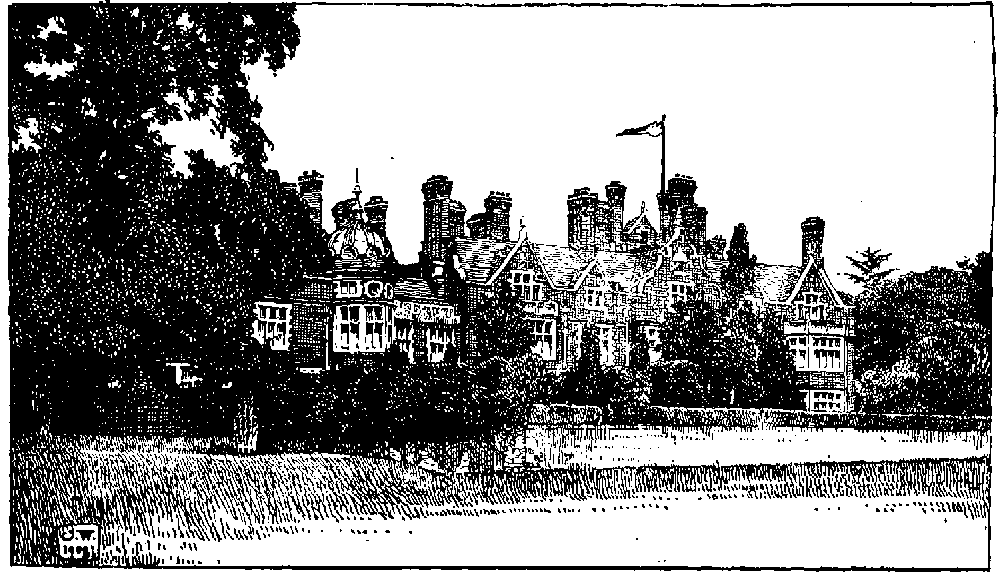
Hurstbourne Priors: Hurstbourne House
Hurstbourne House, a Jacobean building of red brick and yellow carved stone, replaces a former classic building which again took the place of a house which stood actually over the River Bourne at a spot behind the church now called the Cascades. The site of the house is a remarkable one—standing high, immediately overlooking a terraced garden and commanding a view over the deer park and a wide down country, due south, for some 20 miles. The architects of the present house were Messrs. Becston & Burm ster. The entrance is under an elaborately carved porch of heraldic design, within which is a small outer hall, having a marble floor and walls panelled with oak, that opens into the great hall, about 30 ft. high, with a minstrels' gallery, and walls hung with Venetian tapestry. The chimneypiece is of stone and marble with a fine achievement in arms of coloured plaster work. The ceiling and deep cornice are of elaborate Jacobean plaster work. They and the carved oak staircase are after designs of the present earl with the assistance of Mr. Charles Kempe.
There are two long galleries in the house, upper and lower, both lit by windows from the east and west. The upper gallery is hung with pictures. The lower gallery is about 120 ft. long and 16 ft. wide. It contains three mantelpieces of red Italian marble and is hung from end to end with tapestry and lighted by candles in old silver sconces of the 17th century. From this gallery to the south opens a succession of three reception rooms. The saloon, whose walls are entirely covered with tapestry, has a chimneypiece from floor to ceiling designed by the present earl and Mr. Brindley. It is of marbles and painted stone. The furniture includes the finest specimens of French cabinets (Louis XIV and XV), a buhl clock and a suite upholstered in Gobelin tapestry, that were formerly in the collection of the first Lord Tweedmouth at Guisachan. The library is a long room; its bookcases and its two mantelpieces are of Italian walnut. One portion is exclusively devoted to books and prints connected with Hampshire. The other characteristics of the library are family papers, including those of Sir Isaac Newton, a very fine collection of county histories, and interesting collections of scarce memoirs and of books on sport and on art. It also contains a valuable collection of early printed books made by Mr. Edward Pease, the father of the present Lady Portsmouth. The morning-room and dining-room are hung with family and other pictures and miniatures. There are also four very large ivories, the work of Benvenuto Cellini, brought by the first earl from Italy. In the dining-room of the private wing is a most interesting collection of relics of Sir Isaac Newton, which came to the family through the marriage of Newton's great-niece with Lord Lymington.
When Robert Oxenbridge purchased Hurstbourne Priors in 1558 'there was in the park a lodge and a fayre Manor House,' and a royalist officer, writing just before the second battle of Newbury, describes the estate as 'a fayre old house and large park with many ewe trees' (fn. 2) The ' fayre old house ' represented the old mansion known as the Grange that stood over the river.
The River Bourne takes a south-westerly course through the parish, and runs between the village and the park, and the Test marks the south-east boundary of the parish.
The village habitations are scattered, and on the Andover and Basingstoke road, which runs east and west through the village, is Manor Farm, which may possibly represent the manor-house of the manor of Hurstbourne Exterius mentioned in many records. In the extreme south-western corner of the parish is Faulkner's Down Farm, preserving the name of a family who flourished in this parish from the early part of the 13 th century onwards. (fn. 3) Further north are Apsley Farm (which is mentioned in a notice in the belfry of St. Mary Bourne Church stating that Mrs. Longman, of Apsley Farm, gave a chandelier in 1807), (fn. 4) and the little hamlet of Pratt's Down, which contained a mill in 1602, (fn. 5) and on the other side of the railway near the Harrow Way (an ancient Saxon route) is New Barn Farm, where the court leet of the manor was held as late as during the lifetime of the third Earl of Portsmouth. (fn. 6)
Remains of a Roman villa have been discovered at New Barn Down, near Duty Corner, three-quarters of a mile east of the railway station. They consist of fragments of stone, roof tiles and pottery and distinct traces of a dwelling-house, masonry, stucco, Samian and other pottery, while part of a tile and some pottery were found in Hurstbourne Priors churchyard. (fn. 7)
The commons were inclosed under an award dated 1787. (fn. 8)
Some place-names mentioned in early records are Wykenesham by Thurmyngley Wood, a field called Wynerde (1333), (fn. 9) land called Upper and Lower Ower and a field called Winsome Field (fn. 10) (1636).
The chief crops are wheat, barley, oats and turnips.
Manors
The manor of HURSTBOURNE PRIORS, DOWN HURSTBOURNE, or NETHER HURSTBOURNE, (fn. 11) including the tithings of St. Mary Bourne, Stoke Binley, Week and Egbury, was given to a certain Prince Hemele by King Beortric in exchange for land on the River Meon before the year 790. (fn. 12) The former granted it to the monks of Abingdon, from whom it was shortly afterwards acquired by King Egbert (802–839). (fn. 13) The property, consisting of 50 'manentes' at Hurstbourne and 10 at Stoke, (fn. 14) passed to his son Ethelwulf, who bequeathed it to his son Alfred, with reversion to the monks of Winchester for the support of the refectory. (fn. 15) The monks, who appear to have been given possession during the lifetime of Alfred, complained that they were unable to bear the heavy charges laid upon the land, and they were relieved by King Alfred, who regranted them the property under easier conditions. (fn. 16) They were, moreover, confirmed in their possession by a special clause in Alfred's will (885). (fn. 17)
The gift was confirmed by Edward the Elder in 901, (fn. 18) but it appears evident that the land was subsequently unlawfully taken from the monks, as King Edred (946–55) is said to have restored this manor to them. (fn. 19) King Edgar either granted or confirmed this property to the monks at Abingdon in 961, (fn. 20) but on the death of Edgar these royal estates were resumed by order of the Witan, and Ethelred in 993 granted other lands in compensation to Abingdon and confirmed Hurstbourne to Winchester. (fn. 21) At the time of the Domesday Survey it is described as belonging to the church of Winchester. Its value had increased since the time of King Edward the Confessor from £26 to £40, and there were five mills on the manor worth 25s. (fn. 22)
Less than a century later the same manor is called Hurstbourne 'Prioris,' (fn. 23) and in 1205 Pope Innocent III confirmed the prior and monks in possession of the manor, (fn. 24) while the Bishop of Winchester made a similar confirmation in 1285. (fn. 25) The prior and convent continued in possession until the Dissolution in 1535, (fn. 26) when the manor fell into the hands of the king, who appointed Ellis Wynne bailiff. (fn. 27)
In 1547 the whole of the Hurstbourne estate, by the description of 'the manors of Hursborne, Hursborne Interius (Hurstbourne Priors) and Hursborne Exterius (Hurstbourne Fauconers) and the Park of Hursborne,' &c, was granted by the king to Edward Duke of Somerset, (fn. 28) who held it until his death on Tower Hill in 1552. The property then escheated to the king, who, in May 1553, granted it to his vice-chamberlain and captain of the guard, Sir John Gate. The latter was concerned in the attempt to place Lady Jane Grey on the throne, and was executed in August 1553. (fn. 29)
In 1558 Sir Robert Oxenbridge purchased the manor from the Crown, (fn. 30) and it remained in the possession of this family for nearly a century. The first Robert died in 1574 and was succeeded by his son Robert, who died in 1591. (fn. 31) His son and namesake died seised in 1616. (fn. 32) Sir Robert Oxenbridge, son of the latter, who died unmarried in 1638, sold his manor of Hurstbourne Priors in 1636 for £1,747 12s. 4d. to Sir Henry Wallop, of Farleigh Wallop, another old place in the county, the property of the present Earl of Portsmouth, whose son Robert was one of the judges of King Charles, (fn. 33) and was attainted at the Restoration, when his estates were confiscated. (fn. 34) He died in the Tower in 1667, and his son Henry then succeeded to his estates, which had been granted to Sir Robert's brother-inlaw, Thomas Earl of Southampton. (fn. 35)
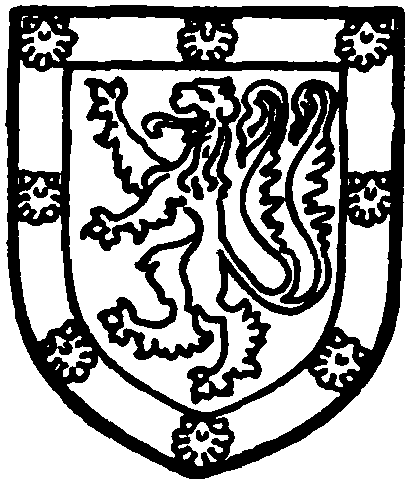
Oxenbridge. Gules a lion argent with a forked tail in a border vert with scallops argent thereon.
The manor has remained in the possession of the Wallop family ever since. (fn. 36) John grandson of Sir Henry was created Viscount Lymington in 1720 and Earl of Portsmouth in 1743; he died in 1749, and was succeeded by his grandson the second earl, whose mother was a niece of Sir Isaac Newton. The third earl was succeeded by his brother Newton Fellowes, of Eggesford (co. Devon), who died in 1854. The fourth earl was succeeded by his son the fifth earl. The sixth and present earl, now owning the property, is the son of the fifth earl. (fn. 37)
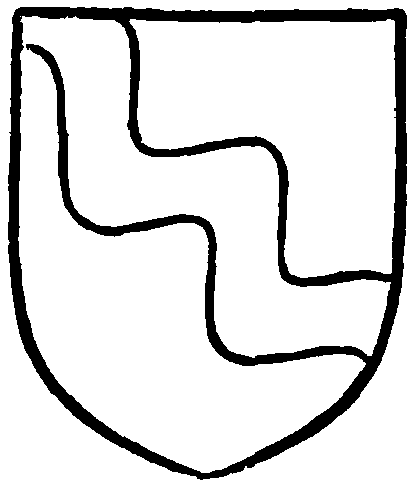
Wallop, Earl of Portsmouth. Argent a bend wavy sable.
Extensive liberties in their lands were granted to the Bishop, Prior and monks of St Suithun in 1231, (fn. 38) and in 1280 the Prior of St. Swithun, as lord of the manor of Hurstbourne, had the following rights, viz. the returns of writs, estreats, summonses, view of frankpledge, gallows, assize of bread and ale, infingenthef, chattels of felons, warren and free chase for taking all manner of beasts and pleas of withernam. (fn. 39)
Free warren was confirmed to the lord in 1300, and the warren which was called Bradley or Badley was farmed out at £2 6s. 8d. (fn. 40)
In 1485 the prior had occasion to bring an action against Henry Hepkyn for breach of his privilege (fn. 41); fishery in Colles lake (in St. Mary Bourne) was also the right of the lord of the manor. (fn. 42) In 1332 licence was given to the Prior of St. Swithun, Winchester, to impark his wood at Hurstbourne. (fn. 43) This became the 16th-century park often referred to, (fn. 44) which when sold by Sir Robert Oxenbridge to Sir Henry Wallop in the 17th century contained 350 acres. There is a record of a request from the Dean and Chapter of Winchester in 1660 'for an allowance of convenient timber from Husbornc Park that they may rebuild their demolished cloisters, library, dwelling house, &c.' (fn. 45)
Six mills are mentioned under Hurstbourne in the Domesday Survey, five on the main manor worth 25s. and one on Geoffrey's holding worth 20s. 6d. (fn. 46)
At the Dissolution there were apparently three belonging to the manor; one in Hurstbourne demised to Richard Cowpar at a rent of 20s., a fulling mill called Robhodismyll or Rodeswoode Mill demised to Robert Regill at a rent of £1 5s. 4d. and a water-mill in St. Mary Bourne, in the tenure of Thomas Power. (fn. 47) Two other mills are mentioned in 1602, one at Chapmansford and one called Pratsdowne Mill, (fn. 48) and in the sale of Sir Robert Oxenbridge's property in 1636 four water-mills are mentioned. (fn. 49)
The manor of HURSTBOURNE FAUCONERS or HURSTBOURNE EXTERIUS (Fawkener 1600) is probably represented by the 5 hides which Geoffrey held of the Bishop of Winchester and which three thegns, 'who could not betake themselves anywhere,' had previously held. (fn. 50) The overlordship continued with the see of Winchester for several centuries, the bishop being returned as the overlord as late as 1541. (fn. 51)
It is probable that the estate passed with the manor of Bradley in the hundred of Overton (q.v.) to Emma des Roches, who in 1263 quitclaimed to Ralph Fauconer all her right in a messuage and 1 carucate of land in Hurstbourne together with 1 hide of land and all other lands and tenements which Ralph held of the fee of Emma in that vill in return for a rent of 8 silver marks. (fn. 52)
The right to this rent passed to the family of Brocas of Beaurepaire through the marriage of Mary, a descendant of Emma des Roches, with Sir Bernard Brocas, who died in 1395, (fn. 53) but in course of time this right was allowed to lapse. In the reign of Henry VII William Brocas, a descendant of Sir Bernard, claimed £42 13s. 4d. as arrears for eight years, and his bailiffs seized the cattle of one William Wygmore at Court Plate or Court Hayes parcel of the manor of Hurstbourne Fauconers; William pleaded that the manor was leased to him by John Fauconer, but the latter failed to appear and the suit was unfinished. (fn. 54)
In 1332 John le Fauconer, probably a descendant of Ralph, described as kinsman and heir of William Fauconer and Emma his wife, exchanged lands in Hurstbourne Priors with the Prior and convent of St. Swithun's (fn. 55) and he was returned in 1346 as owner of half a fee in Hurstbourne previously held by William le Fauconer. (fn. 56) Nicholas Fauconer dealt by fine with one messuage, 2 carucates of land in Hurstbourne Priors, Stoke and St. Mary Bourne (fn. 57) in 1381, and in 1411 he still had property in Hurstbourne. (fn. 58) In 1428 John Fauconer held half a knight's fee in Hurstbourne formerly held by the earlier John, (fn. 59) and another John was lord of the manor in 1500. (fn. 60)
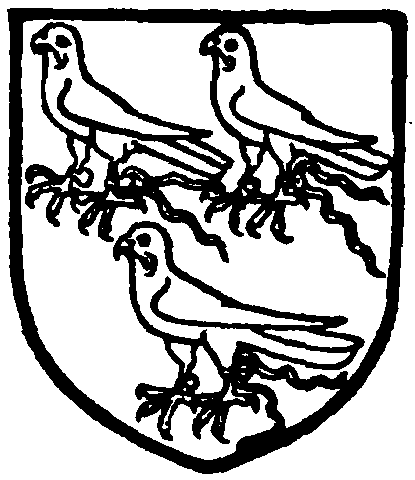
Fauconer. Sable three falcons argent with their bells and jesses or.
In 1540 Richard Fauconer died seised of Hurstbourne Fauconers, which passed to his son Richard, who died in 1551, (fn. 61) leaving three sisters, Elizabeth, Margaret and Alice, heirs of his property, (fn. 62) while his wife Frances held one-third during her lifetime. (fn. 63)
Of these Elizabeth married Thomas Yate and left a son Francis, who in 1563 sold his third part of the manor to Richard Kingsmill, who had married Alice on the death of her first husband William Wroughton. (fn. 64) In 1574 Richard settled the property upon his second wife Elizabeth Stonehouse with remainder to Constance wife of Sir Thomas Lucy, his daughter by his first wife. He died seised of two-thirds of the manor, designated 'the manor,' in 1600. (fn. 65)
Lady Constance Lucy (who died in 1637) and her husband settled the manor of Hurstbourne Fauconers upon their second son, Sir Richard, created a baronet in 1617, (fn. 66) whose grandson, Sir Berkeley Lucy, was holding in 1693. (fn. 67) He had only one child, Mary, (fn. 68) who married the Hon. Charles Compton, one of the younger sons of the fourth Earl of Northampton. (fn. 69) They had a son Charles, who succeeded to the earldom and inherited the manor of Hurstbourne Fauconers in 1759 in accordance with the terms of the will of his maternal grandfather, Sir Berkeley Lucy (fn. 70); he died in 1763, and directed that his property should be sold and that after various legacies had been paid off the remainder of the proceeds should go to Spencer Compton, his brother. (fn. 71)
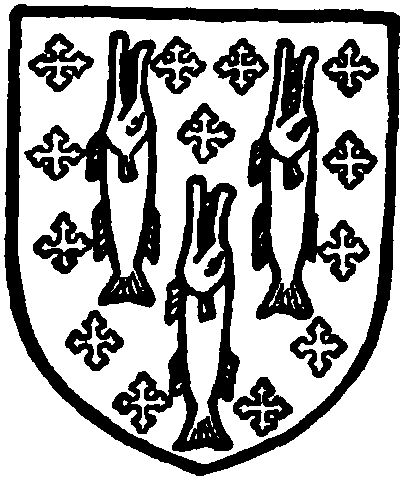
Lucy. Gules pondered with crosslets argent and three luces argent.
The Earl of Portsmouth is found holding the manor in 1790, having probably purchased it after the death of the Earl of Northampton, (fn. 72) and from that time it has followed the descent of Hurstbourne Priors.
A mill existed in this property in 1086. (fn. 73)
There was another holder under the bishop in Hurstbourne in 1086 whose property has not yet been identified—William, who was holding 2 hides less half a virgate. (fn. 74) Sawin held them before him, 'and could not betake himself anywhere.'This holding was worth at one time £6, but at the time of the Survey it was valued at 40s. (fn. 75)
Rectory Manor
In 1086 Lewin held 1 hide in Hurstbourne of the Bishop of Winchester, together with the church; he had a team of 7 oxen and 2 acres of meadow, the property being worth in all 50s. (fn. 76) The church was appropriated by the bishop to the Hospital of St. Cross at its foundation in 1132, and confirmed to it in 1189. (fn. 77) The duties which the tenants upon this land owed to the hospital are summarized in a register of the estates belonging to the hospital before the year 1386; the place at which the manor courts were held was rented by the prior at 12d. a year, and the total annual rent of assize was then £4 6s. 7½d. (fn. 78) In 1535 the value in land tithes and oblations was £13 6s. 8d. (fn. 79)
In the 16th century this property was leased out by the hospital, the charges on it being the annual payment of '40 quarters of pure clean wheat of good measure, 60 quarters of good barley malt, and £33 6s. 8d.; also to the vicar of Husborne (being resident upon his vicarage and keeping hospitality there) 4 quarters of good wheat, 4 of barley malt; if the said vicar be not resident there the said wheat and barley to be delivered at the house of St. Cross.' (fn. 80) The property is now in the hands of the lay rector, the Earl of Portsmouth. (fn. 81)
Church
The church of ST. ANDREW consists of a chancel 24 ft. I in. by 17 ft. 5 in., north chapel 24 ft. 7 in. by 16 ft. 1 in., nave 49 ft. 9 in. by 22 ft., with a south transept known as the Portsmouth aisle 14 ft. I in. by 11 ft. 7 in., and a west tower 11 ft. 11 in. square.
The oldest portion of the building is the chancel, which is of 13th-century date; but there are two arches, which show that there was formerly a 12th-century building here: one of these is now the west doorway of the tower, and the other is the entrance to the north chapel from the chancel. This appears to have once been the chancel arch, which was probably moved to its present position, and the present arch formed, when the north chapel was built in the 16th century. The south transept is an addition of the 18th century, and the nave was rebuilt and the tower added in 1870.
The east window of the chancel has three cinquefoiled lights and tracery of late 15th-century date. Against the east wall is an arched recess 4 ft. 10 in. deep, which rises a little higher than the rear arch of the east window. It is two-centred, and has two small chamfers on its outer edge. Below the springing on each side is an arcade of two small bays of late 12th-century character, with carved or moulded capitals and moulded bases. The arches are semicircular, with chamfered edges. Both the springing stones of the west bays and the western capital and base are modern, and the whole is obviously a make-up of old details.
In the north wall of the chancel is a fine canopied tomb, described below, to the west of which is the 12th-century arch already referred to. This has plain jambs recessed on the south side, a chamfered abacus and a semicircular arch of two orders, the inner one being plain while the outer is enriched with zigzag ornament, and beyond this is a label of diapered ornament. The north side of the arch is quite plain.
The south wall of the chancel contains two 13th-century lancets, chamfered and rebated outside, and between them is a blocked doorway of the same date which has beaded jambs and two-centred arch and a hollow moulded label. On it is incised a sundial.
The north chapel has an east window of five uncusped four-centred 16th-century lights, under a square head with a moulded label. There are two similar three-light windows but without labels in the north wall, and in the west wall a modern window of five lights. At the north-west is a doorway which has a four-centred head, and is contemporary with the windows. The chancel arch has two chamfered orders continued from the jambs, and seems to be modern.
The nave has three modern windows on the north side and two on the south, each of three cinquefoiled lights, with tracery of 15th-century style.
The arch to the south transept is like the chancel arch, but with the inner order resting on moulded corbels.
The tower is of brick with stone dressings and battlemented parapet, with a stair turret on the northeast angle; it is built in an imitation of 12th-century style, the only old detail in it being the west doorway, which has recessed jambs with angle shafts and scalloped capitals with chamfered abaci. The arch details are like those of the arch in the north wall of the chancel.
The tomb in the north wall of the chancel is that of Sir Robert Oxenbridge, 1574, son of Godard Oxenbridge, and sometime Constable of the Tower, and also to his wife, daughter of Thomas Fogge, knight. The inscription is painted on the north side of the tomb, on the plinth of one of the Doric columns flanking the tomb, and is now very much damaged and partly illegible. On the south side is a later inscription to Robert Oxenbridge, of Piddle Trenthide, in the county of Dorset, who died in 1705, and his wife, who died two years later.
On the slab of the tomb are the recumbent effigies of Sir Robert. and his wife. He is represented in full armour with a helm beneath his head.
The base of the tomb has a cornice supported by medillions, with small fluted columns at the corners, and below are panels framed in a guilloche border with figures of three sons and four daughters on both sides of the tomb.
The canopy is square-headed with fluted Ionic columns supporting a cornice enriched with medillions.
The arms of Sir Robert and his wife appear above their heads at the side of the canopy and on the soffit, and his arms occur again in the centre above the cornice.
The tower contains a ring of six bells, the treble having the mark of Ellis Knight, and of Henry Knight, with the date 1667 and the inscription, 'I as treble singe.' The second is inscribed, 'I as second sing'; the third, 'I as third ring'; the fourth, 'I as fourth sound'; the fifth, 'I as tenar hum all round 1631'; and the sixth, now the tenor, is by Henry Bagley 1741.
The plate consists of a silver chalice indistinctly dated; two silver patens, one inscribed 'The guift of Dorothy Wallop to ye church of Downe Husband 1682,' the other dated 1894 a Jubilee offering of 1897; and a silver flagon of 1692 given by John Wallop in that year.
The registers are contained in four books, the first having baptisms 1621 to 1740, marriages 1604 to 1739, and burials 1604 to 1681. The second contains baptisms 1740 to 1812, marriages 1740 to 1754, and burials 1678 to 1812, and some briefs dated 1689 and 1707. The third book has marriages from 1755 to 1800, and the fourth the same from 1800 to 1813.
Advowson
A church is known to have existed at Hurstbourne in very early times, as a charter of Bishop Denewulf dated 802 refers to its consecration in that year. (fn. 82) The Bishop of Winchester retained the advowson of the vicarage after appropriating the church to the Hospital of St. Cross, and the vicarage is still in the gift of the Bishops of Winchester. (fn. 83)
There is a Wesleyan chapel in the parish.
The school was built in 1855.
Charities
The parliamentary returns of 1786 mention that one Robert Oxenbridge, some 200 years since, by his will left to the poor, not in receipt of parish relief, money which then amounted to £77. The trust fund now consists of £82 7s. 4d. consols with the official trustees, producing yearly £1 17s., which is distributed in half-crowns.
